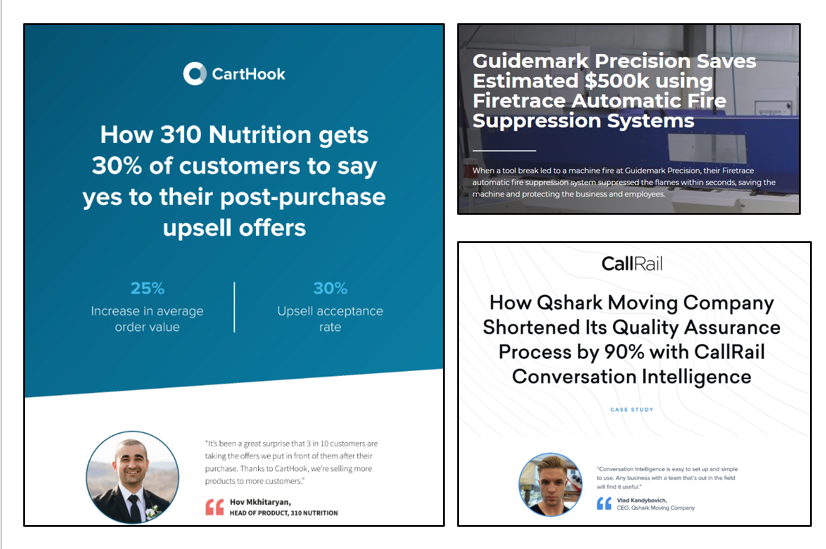Having a good headline is important.
After all, you only have a few seconds to grab readers’ attention.
This is as true for case studies as any other type of marketing content, from blog posts to white papers.
However, case study headlines can get a little… trickier.
Because while you want to grab attention with your case study headline, you also need to make those headlines extra focused.
Why? Because when prospective clients scan your case study headline, they’re looking for some specific things (whether they realize it or not).
Most often, they’re looking for something they can identify with:
- Problems they can relate to
- Brands they’re familiar with
- Industries that are the same or similar to their own
- Results that are relevant to their situation.
As you can see, the overriding theme here is relevancy. Prospective clients want case studies that are relevant to the problem they’re trying to solve.
Prospective clients want case studies that are relevant to the problem they’re trying to solve.
And so, succinctly communicating those relevant factors in your headline—in the right order—is key to reaching your audience.
Let’s dig into how to write a great case study headline:
The Most Common Case Study Headline Formula
Given the above parameters, most customer success story headlines follow this format:
[My Company] gets [Result] for [Customer Name]
So they read something like:
“How My Company Increased Revenue 30% for Customer ABC”
Or, alternatively:
“How My Company Helped Customer ABC Increase Revenue by 30%”
There’s nothing wrong with this format. In some cases, it’s the best choice.
But sometimes, it’s better to change up the order so that the customer name comes before the name of your company.
So the format would be:
[Customer ABC] gets [Result] with the help of [My Company]
So it would read:
“How Customer ABC Increased Revenue 30% With My Company”
The change is subtle. But it’s important for three reasons:
1) Your company name may be redundant
Having your company name in the headline may be redundant depending on the context in which it’s presented.
For example, if you’re putting your case studies on your website, the fact that it was your company that helped obtain those great results will be self-evident because the case studies are on your website.
Further, your company name may already be communicated through design elements, such as your logo.
In these cases, you can safely put your company name at the end of the headline and potentially leave it out altogether.
Here are some examples to illustrate:

As you can deduce, these case studies are for CartHook, CallRail, and Firetrace.
The CartHook and CallRail logos are prominent, so the names aren’t included in the headline at all.
The company name “Firetrace” is included, but it comes after the customer name.
For each of these, the design (and possibly the context) help make the company name self-evident, so it works in these cases.
Obviously, leaving your company name out of the headline—or pushing it to the end—is something you’ll want to test for each use case. But you may find it’s an improvement.
2) You need to make the customer the hero
Another reason to put your customer’s name first: it positions them as the hero of their story.
After all, they deserve to get credit for the results! They’re the ones who made the smart decision to hire you. So use the headline to put them squarely in the driver’s seat.
Use the case study headline to put your customer squarely in the driver’s seat.
Besides, your customer is doing you a favor by agreeing to participate in your case study. You want them to come out looking proactive, smart and in control—and not like a desperate organization that needed rescuing.
Further, when you make customers look great, they’re more likely to share the case study with their network. And if you ask them to participate in a future case study, they’re more likely to agree.
In addition, when you ask other customers to participate in a case study, you can bet they’ll check out your existing case studies. And if they don’t like what they see, they’ll say no.
If you want them to say yes, you need to make them look good from the headline and all the way through.
3) You still have room for creativity
So far, we’ve talked about two different case study headline formulations. These formulas might be the best headline choice 85 percent of the time.
But sometimes you have room to step outside those formulas.
Other times, you have no choice but to take a more creative approach.
This is often the case when you don’t have quantitative case study metrics you can use. When that happens, you have to find a different way to draw attention.
For example, one of our case study writers (yay, Annie!) wrote this headline:

With no metrics to feature, Annie opted to start the headline with a short, to-the-point quote that sums up the whole customer experience (“We don’t have to worry about DevOps”).
At the same time, she’s made sure the customer (Bounce House) is the hero of the story.
She’s gotten the best of both worlds: a creative, grabby headline that still clearly communicates the most important info.
Go Beyond Your Traditional Case Study Headline Formula
We hope we’ve convinced you to rethink your case study headlines.
It’s not that “traditional” case study headline formulas are bad. Not at all.
It’s just that sometimes, in some cases, there are other options that are worth testing.
When you do, you may find that a couple of subtle tweaks make a big difference in grabbing your target audience.
Need help with your case study headline—and everything else that goes along with it?
Contact us to start the conversation.